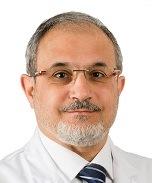Thyroid cancers

Differentiated thyroid cancer
Summary/Epidemiology
Thyroid cancer is the most common endocrine malignancy. The annual incidence of thyroid cancer has been increasing in recent years, probably due to the refinement of diagnostic methods, which has led to the detection of tumors that previously remained unrecognized. Like most thyroid diseases, thyroid cancer is more common in women. Thyroid cancer progresses slowly and has a favorable prognosis.
Risk factors
Thyroid cancer is promoted by accidental exposure to ionizing radiation as well as by genetic factors.
Symptoms
Thyroid cancer often presents as an asymptomatic thyroid nodule, discovered on clinical examination or incidentally on imaging for another condition. More rarely, the appearance of a cervical lymph node, voice changes, or difficulty swallowing may reveal the diagnosis.
Diagnosis and examinations
The diagnosis of thyroid cancer is made using imaging techniques and fine needle aspiration biopsy. Ultrasound of the thyroid gland provides important information about "nodules," which are small tumors that develop in the thyroid but may not be cancer. Ultrasound is thus coupled to puncture of the nodule with a fine needle and microscopic analysis of the cells collected by the puncture. These different examinations must be carried out with great care in order to guarantee their reliability.
The genetic abnormalities involved in the development of thyroid cancer have been almost completely identified through the Cancer Genome Atlas study in 2014. The emergence of molecular biology techniques (e.g. NGS) currently makes it possible to identify these abnormalities on the puncture material of the thyroid nodule and thus refine its diagnosis. In the future, this will make it possible to avoid unnecessary or too extensive surgery.
In some cases, the assessment is completed by a scintigraphy. Scintigraphy consists in intravenously injecting a very small quantity of radioactive product taken up by the thyroid. An instrument, placed near the neck, detects the radiation emitted by the product. Scintigraphy can be useful to better define the function of the nodule(s).
The information provided by these different examinations guides the choice of treatment.
Traitements
La démarche conduisant au diagnostic de cancer de la thyroïde est subtile et la décision de procéder à une intervention chirurgicale est prise au terme d’une réflexion à laquelle participent tous les experts concernés : endocrinologues, radiologues, nucléaristes, pathologistes et, chirurgiens…Cette approche pluridisciplinaire permet de dégager l’attitude la plus appropriée pour chacun des cas discutés.
L’efficacité du traitement repose d’abord sur une approche chirurgicale performante. La chirurgie de la thyroïde, qui consiste en l’ablation partielle ou complète de la glande (thyroïdectomie) est délicate eu égard à la proximité des cordes vocales et des glandes parathyroïdes. Les parathyroïdes sont des glandes de petite taille, très proches de la thyroïde, impliquées dans la régulation du calcium et du phosphore dans le sang. La dextérité du chirurgien permet de contrôler les risques potentiels de l’acte chirurgical.
L’administration d’iode radioactif complète souvent l’intervention. L’iode est indispensable à la synthèse des hormones thyroïdiennes et l’iode radioactif est capable de détruire les quelques cellules de la thyroïde qui ont échappé à la chirurgie.
Le traitement complémentaire par radio-iode impose des mesures de radioprotection destinées à préserver l’entourage et l’environnement. Il nécessite une chambre d’isolement blindée dans laquelle le malade est hospitalisé durant deux à trois jours.
La chirurgie et l’iode radioactif conduisent généralement à la guérison du cancer. Le suivi, indispensable en raison du risque de récidive, est aisé et repose sur un test très fiable en l’occurrence le dosage de la thyroglobuline dans le sang. La thyroglobuline est la protéine de stockage des hormones thyroïdiennes. Elle est produite de manière spécifique par les cellules de la glande thyroïde. Une thyroglobuline détectable traduit la persistance de cellules thyroïdiennes, cancéreuses ou non, tandis que l’absence de thyroglobuline et celle de tissu thyroïdien résiduel à l’imagerie sont considérées comme des signes de guérison.
Après ablation de la thyroïde, il est nécessaire d’instaurer un traitement de substitution en hormones thyroïdiennes.
Le traitement combiné par chirurgie et iode radioactif permet, dans 95 % des cas, de guérir le cancer de la glande thyroïde. Le risque de récidive impose toutefois un suivi.
Le risque de récidive, principalement dans les 5 à 10 ans, n’est toutefois pas nul de sorte qu’un suivi régulier s’avère nécessaire.Il repose sur un test très fiable : le dosage de la thyroglobuline dans le sang. La thyroglobuline est la protéine de stockage des hormones thyroïdiennes. Elle est produite de manière spécifique par les cellules de la glande thyroïde. Une thyroglobuline détectable traduit la persistance de cellules thyroïdiennes, cancéreuses ou non, tandis que l’absence de thyroglobuline et celle de tissu thyroïdien résiduel à l’imagerie sont considérées comme des signes de guérison.
Après ablation de la thyroïde, il est nécessaire d’instaurer un traitement de substitution en hormones thyroïdiennes.
Si la maladie est plus avancée (présence de métastases dans d’autres organes), inopérable et résistante à l’iode radioactif, des médicaments de thérapie ciblée (inhibiteurs de kinases) peuvent être efficaces. Vu leurs effets secondaires non négligeables, ils sont utilisés au cas par cas après discussion en réunion pluridisciplinaire. La participation à des études cliniques pour évaluer de nouveaux médicaments est également proposée.
Active surveillance of thyroid cancers
In recent years, active surveillance of low-risk thyroid carcinomas has been proposed as an equally effective alternative to immediate surgical intervention. Any adult may benefit from this surveillance if the carcinoma is found to have clinical, ultrasonographic, cytologic, and molecular features indicating a low risk of progression to neighboring organs or distantly. Active surveillance involves regular ultrasound monitoring of the thyroid.
Research / Innovation
The difficulties encountered in the diagnostic and therapeutic approach to thyroid cancer have led the European scientific community to formulate recommendations. The experts of the multidisciplinary group dedicated to thyroid cancer have taken an active part in the elaboration of these consensus texts.
They are also conducting research on the factors that influence the evolution of thyroid cancer. The identification of these markers would allow the therapeutic approach to be further refined. Participation in these studies allows us to offer patients at the King Albert II Institute an approach that is in line with the most recent advances, particularly for the small group of patients with aggressive disease that is refractory to the usual treatment, i.e. surgery and radioactive iodine.
Medullary carcinoma of the thyroid
General information
Less common thyroid cancers include medullary carcinoma. Medullary carcinoma develops from thyroid cells that secrete the hormone calcitonin, the "signature" of the disease. However, calcitonin may be moderately elevated in clinical situations other than cancer, which will be established during the diagnostic workup.
Medullary carcinoma is an inherited cancer in about a quarter of patients and the risk of inheritance can be determined by genetic analysis of blood cells. Sometimes, this cancer is associated with tumors of other endocrine glands to form a "multiple endocrine neoplasia type 2".
Diagnosis
Like differentiated thyroid carcinoma, medullary carcinoma presents as a thyroid nodule, but its diagnosis is based on the determination of calcitonin in the blood rather than on the puncture of the thyroid nodule. Metastases in lymph nodes or other organs are common. High calcitonin secretion may be responsible for diarrhea and hot flashes.
Treatment
Treatment consists of surgical resection of the thyroid gland and, often, the neck lymph nodes. Unlike differentiated thyroid cancer, medullary carcinoma is not sensitive to radioactive iodine. After surgery, the patient is followed up regularly with measurements of calcitonin in the blood. The persistence of high levels of calcitonin is a sign of persistent cancerous disease, which makes it necessary to search for the residual tumor by ultrasound, PET scan, and/or CT scan and then resect it.
If the disease is more advanced (presence of metastases in other organs) or inoperable, targeted therapy drugs (kinase inhibitors) may be effective. Given their significant adverse effects, they are used on a case-by-case basis after discussion in a multidisciplinary meeting. Participation in clinical trials to evaluate new drugs is also proposed.
Preventive thyroid resection should generally be proposed to affected family members of a patient with hereditary medullary carcinoma, after thorough genetic investigation and at an age to be determined with the physician.
Contact
For any further information, or if you would like to make an appointment, please contact the Oncology Care Coordinator at + 32 2 764 78 82.
Doctor

Dr Orsalia ALEXOPOULOU

Pr Selda AYDIN

Dr Antoine BUEMI
Dr Maria-Cristina BURLACU

Pr Alessandra CAMBONI

Pr Emmanuel COCHE

Dr Frank CORNELIS

Pr Tom DARIUS
Dr Raluca FURNICA

Pr Damien GRUSON

Pr François JAMAR
Dr Eléonore LONGTON

Pr Dominique MAITER

Pr Michel MOURAD

Pr Sandra SCHMITZ
Paramedical

Dang TRINH

Carine VANDEUREN

